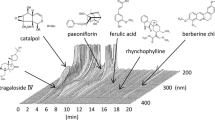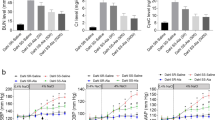Abstract
Shichimotsukokato (SKT) is a Kampo formula, comprising astragalus root, phellodendron bark, rehmannia root, peony root, cnidium rhizome, Japanese angelica root, and uncaria hook. It is prescribed to hypertensive patients who complain of a sensation of a rush of blood to the head, shoulder stiffness, tinnitus, and dull headache. We investigated the effects of SKT on renal hypertension in Wistar rats subjected to a 5/6 nephrectomy (Nx). Systolic blood pressure (SBP) increased markedly after surgery and remained high in the Nx rats. Oral treatment of SKT extract at dosages of 0.75 and 1.5 g/kg/day (corresponding to 5- and 10-fold human dosages, respectively) caused a significant suppression of the increase in SBP in Nx rats. Plasma concentrations of nitric oxide (NO) were marginally lower and asymmetric dimethylarginine (ADMA) significantly higher in the Nx rats than in sham-operated rats. SKT administration caused a significant counteraction of these changes. Finally, we evaluated the levels of protein methyltransferase (PRMT), an enzyme that catalyzes the production of ADMA, and the levels of dimethylarginine dimethylaminohydrolase (DDAH), an enzyme involved in the degradation of ADMA, in the remnant kidney. Neither Nx nor SKT treatment affected PRMT-1 or DDAH-1 levels. DDAH-2 levels were reduced significantly in the Nx rats compared with the sham-operated rats. SKT treatment significantly ameliorated this decrease in the DDAH-2 levels. It is considered that SKT reduced blood pressure in the renal hypertension rat model, mediated, at least partially, by the DDAH-ADMA-NO pathway.




Similar content being viewed by others
References
Higuchi Y, Ono K, Sekita S, Onodera H, Mitsumori K, Nara Y, Satake M (1998) Preventive effects of Shichimotsu-koka-to on renal lesions in stroke-prone spontaneously hypertensive rats. Biol Pharm Bull 21:914–918
Hiwara N, Uehara Y, Takada S, Kawabata Y, Ohshima N, Nagata T, Ishimitsu T, Gomi T, Goto A, Ikeda T, Yagi S, Omata O (1994) Antihypertensive property and renal protection by shichimotsu-koka-to extract in salt-induced hypertension in Dahl strain rats. Am J Chin Med 22:51–62
Chanda R, Fenves AZ (2009) Hypertension in patients with chronic kidney disease. Curr Hypertens Rep 11:329–336
Chobanian AV, Bakris GL, Black HR, Cushman WC, Green LA, Izzo JL Jr, Jones DW, Materson BJ, Oparil S, Wright JT Jr, Roccella EJ; National Heart, Lung, and Blood Institute Joint National Committee on Prevention, Detection, Evaluation, and Treatment of High Blood Pressure; National High Blood Pressure Education Program Coordinating Committee (2003) The Seventh Report of the Joint National Committee on Prevention, Detection, Evaluation, and Treatment of High Blood Pressure: the JNC 7 report. JAMA 289:2560–2572
Sakuma Z, Inoue M, Sekita S, Satake M, Ogihara Y (1998) Enhancement of serum nitric oxide by Shichimotsu-koka-to (Kampo medicine). Biol Pharm Bull 21:1079–1083
Waldherr R, Gretz N (1988) Natural course of the development of histological lesions after 5/6 nephrectomy. Contrib Nephrol 60:64–72
Hewitson TD, Ono T, Becker GJ (2009) Small animal models of kidney disease: a review. Methods Mol Biol 466:41–57
Erdely A, Wagner L, Muller V, Szabo A, Baylis C (2003) Protection of wistar furth rats from chronic renal disease is associated with maintained renal nitric oxide synthase. J Am Soc Nephrol 14:2526–2533
Fleck C, Appenroth D, Jonas P, Koch M, Kundt G, Nizze H, Stein G (2006) Suitability of 5/6 nephrectomy (5/6NX) for the induction of interstitial renal fibrosis in rats—influence of sex, strain, and surgical procedure. Exp Toxicol Pathol 57:195–205
Vallance P, Leone A, Calver A, Collier J, Moncada S (1992) Accumulation of an endogenous inhibitor of nitric oxide synthesis in chronic renal failure. Lancet 339:572–575
Baylis C, Mitruka B, Deng A (1992) Chronic blockade of nitric oxide synthesis in the rat produces systemic hypertension and glomerular damage. J Clin Invest 90:278–281
Moncada S, Higgs EA (1995) Molecular mechanisms and therapeutic strategies related to nitric oxide. FASEB J 9:1319–1330
Vallance P, Leiper J (2004) Cardiovascular biology of the asymmetric dimethylarginine:dimethylarginine dimethylaminohydrolase pathway. Arterioscler Thromb Vasc Biol 24:1023–1030
Liu H, Qu X, Liang Z, Chen W, Xia W, Song Y (2008) Variance of DDAH/PRMT/ADMA pathway in atrial fibrillation dogs. Biochem Biophys Res Commun 377:884–888
Fiedler L (2008) The DDAH/ADMA pathway is a critical regulator of NO signalling in vascular homeostasis. Cell Adh Migr 2:149–150
Leiper JM, Santa Maria J, Chubb A, MacAllister RJ, Charles IG, Whitley GS, Vallance P (1999) Identification of two human dimethylarginine dimethylaminohydrolases with distinct tissue distributions and homology with microbial arginine deiminases. Biochem J 343(Pt 1):209–214
Fliser D, Kronenberg F, Kielstein JT, Morath C, Bode-Böger SM, Haller H, Ritz E (2005) Asymmetric dimethylarginine and progression of chronic kidney disease: the mild to moderate kidney disease study. J Am Soc Nephrol 16:2456–2461
Matsumoto Y, Ueda S, Yamagishi S, Matsuguma K, Shibata R, Fukami K, Matsuoka H, Imaizumi T, Okuda S (2007) Dimethylarginine dimethylaminohydrolase prevents progression of renal dysfunction by inhibiting loss of peritubular capillaries and tubulointerstitial fibrosis in a rat model of chronic kidney disease. J Am Soc Nephrol 18:1525–1533
Tsukada T, Yokoyama K, Arai T, Takemoto F, Hara S, Yamada A, Kawaguchi Y, Hosoya T, Igari J (1998) Evidence of association of the ecNOS gene polymorphism with plasma NO metabolite levels in humans. Biochem Biophys Res Commun 245:190–193
Zhou ZY, Tang YP, Xiang J, Wua P, Jin HM, Wang Z, Mori M, Cai DF (2010) Neuroprotective effects of water-soluble Ganoderma lucidum polysaccharides on cerebral ischemic injury in rats. J Ethnopharmacol 131:154–164
Song J, Meng L, Li S, Qu L, Li X (2009) A combination of Chinese herbs, Astragalus membranaceus var. mongholicus and Angelica sinensis, improved renal microvascular insufficiency in 5/6 nephrectomized rats. Vascul Pharmacol 50:185–193
Lee BC, Choi JB, Cho HJ, Kim YS (2009) Rehmannia glutinosa ameliorates the progressive renal failure induced by 5/6 nephrectomy. J Ethnopharmacol 122:131–135
Takayama H (1988) Fukusho Zukai Kampo Joyo Shoho Kaisetsu. Taishindo, Tokyo
Acknowledgments
This research was supported by Grants-in-Aid for Scientific Research (KAKENHI) C, #21590172 (2009).
Author information
Authors and Affiliations
Corresponding author
Rights and permissions
About this article
Cite this article
Bai, F., Makino, T., Ono, T. et al. Anti-hypertensive effects of shichimotsukokato in 5/6 nephrectomized Wistar rats mediated by the DDAH-ADMA-NO pathway. J Nat Med 66, 583–590 (2012). https://doi.org/10.1007/s11418-011-0625-8
Received:
Accepted:
Published:
Issue Date:
DOI: https://doi.org/10.1007/s11418-011-0625-8




